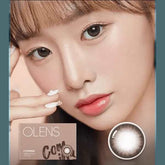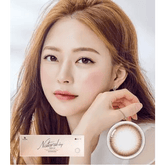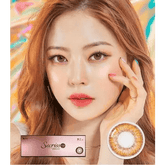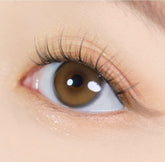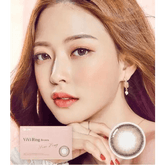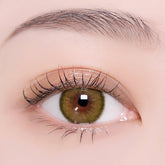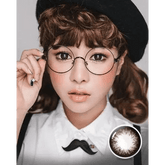I have tried many contacts and these are my favorite for my hazel eyes. They match my eyes' natural pattern and blend beautifully while keeping my limbal ring.
- Home
-
- Colored Contacts
- BY COLOR
-
For Disposable
- For Disposable
- Daily Contacts
- Monthly Contacts
- Biweekly Contacts
- 6 Months Contacts
-
By Effects
- By Effects
- No Black Rim
- Reduced Pupil
- Enlarging Contacts
- BY GRAPHIC DIAMETER
-
BY MATERIAL
- BY MATERIAL
- HEMA
- Silicone Hydrogel
- Phosphorylcholine
- PC + Silicone Hydrogel
- BY WATER CONTENT
- BY BASE CURVE
-
For Toric & Astigmatism
- For Toric & Astigmatism
- OLENS Toric
- LENSTOWN Toric
- Circle Lenses
- Contact Lenses
- New Arrivals
- Top Picks
- Toric Contact Lenses
- Login
- Creat Account
- Get in Touch
Buy1, Get1 Free!
Start Saving💕 Clean & Secure Disposables! 💕
🌷 Discover Unique Specialty Contacts 🌷

Colored Contacts for Astigmatism
Colored contact lenses designed for individuals with astigmatism, providing both vision correction and the option to change eye color.

Cheap Colored Contacts Under $10
Affordable colored contact lenses available for under $10, offering a budget-friendly way to experiment with different eye colors.

Contact Lenses
Transparent contact lenses that don't change the natural eye color, ideal for those who want vision correction without altering their appearance.

No Black Rim Colored Contacs
Colored contact lenses without a black outer ring, creating a more subtle and natural-looking eye color change.

Enlarging Colored Contacts
Contact lenses designed to make the eyes appear larger, enhancing the appearance of your eyes for a more doll-like or dramatic look.

Reduced Pupil Colored Contacts
Colored lenses with a smaller or less noticeable pupil hole, providing a unique and captivating eye effect when worn.
✅ FAQ about Color Contact Lenses ✅
KPOP2's delivery process consists of two main steps to ensure your order is prepared and shipped efficiently.
Order Preparation
Preparation Time:
All orders take approximately 2-3 days to prepare for shipping, excluding weekends. During this time, we ensure that your products are carefully packed and ready for dispatch.
Shipping Options
Standard Shipping:
Cost-Effective: This option is budget-friendly but slower, typically taking about 21-30 days for delivery.
Considerations: While it is the most economical choice, please be aware that delivery times may vary based on external factors.
Fast Delivery:
Speedy Option: Fast delivery significantly reduces waiting time to 2-5 days, allowing for quicker and safer delivery of your order.
Recommendation: We recommend choosing this option for a more efficient delivery experience.
External Factors
Variable Delivery Times:
Delivery periods may fluctuate due to external factors such as:
Region
Selected delivery method
Sales periods
Public holidays
Strikes
Natural disasters
Customs Duties:
Please note that any customs duties are the responsibility of the customer, and it is advisable to check with local customs regulations to anticipate any additional fees.
Special Note on Toric Lenses
Toric Lenses Customization:
Toric lenses may require additional time for customization, taking an extra 2-3 weeks before they can be shipped.
Yes, colored contacts are suitable for those with perfect vision.
Understanding Plano Lenses
Plano or Non-Prescription Lenses:
These lenses, often referred to as 'plano' lenses, are designed purely for cosmetic purposes. They offer a way to change your eye color without affecting your vision.
Cosmetic Enhancement:
Colored contacts are ideal for individuals seeking to enhance or alter their appearance for fashion, theatrical reasons, or special occasions. They provide a versatile option for expressing personal style.
Importance of Professional Fitting
Fitting and Prescription:
Even though these lenses do not correct vision, they must still be fitted and prescribed by an eye care professional.
This step is crucial to ensure proper eye health and comfort.
Monitoring Eye Health:
A professional fitting includes assessing the shape and size of your eyes, helping to ensure that the lenses fit correctly and do not cause irritation or discomfort.
Yes, colored contacts are safe with proper usage and care.
Ensuring Safety with Colored Contacts
Source from Reputable Manufacturers:
Safety in using colored contact lenses heavily depends on sourcing them from reputable manufacturers and suppliers. Choose brands that adhere to high standards of quality and safety.
Follow Usage Guidelines:
It is essential to follow all prescribed usage guidelines, which include:
Proper Cleaning: Clean your lenses with the appropriate contact lens solution before and after each use to prevent infections.
Correct Storage: Store lenses in a clean lens case filled with fresh solution to keep them moist and free from contaminants.
Handling Techniques: Always wash and dry your hands before handling your lenses to avoid transferring bacteria.
Regular Eye Check-Ups:
Regular eye check-ups are necessary to monitor your eye health. Your eye care professional can help ensure that your lenses remain suitable for your eyes and can detect any potential issues early on.
Addressing Discomfort:
If you experience any discomfort or notice visual changes while wearing colored contacts, it is crucial to discontinue use immediately and consult an eye care professional. Prompt attention can help prevent more serious complications.
Colored contacts should not be worn for more than 8-10 hours daily.
Recommended Duration
Optimal Eye Health and Comfort:
This duration is recommended to maintain optimal eye health and comfort. Wearing colored contacts for extended periods can lead to various issues.
Risks of Over-Wearing:
Over-wearing colored contacts can lead to:
Eye Strain: Prolonged use may cause fatigue and discomfort in the eyes.
Dry Eye: Lenses can restrict oxygen flow to the cornea, leading to dryness and irritation.
Increased Risk of Complications: Extended wear heightens the risk of infections and other complications, such as redness or inflammation.
Importance of Eye Breaks
Need for Rest:
The eyes need time to breathe and rest. It's important to give them a break from lens wear, especially before sleep.
Enhancing Eye Health:
Adhering to this daily wear limit ensures that your eyes remain healthy while still allowing you to enjoy the cosmetic benefits of colored contacts.
Final Thoughts
By following the recommended 8-10 hour wear limit, you can help prevent discomfort and maintain the health of your eyes. Always prioritize your eye care while indulging in the aesthetic appeal of colored lenses.
A prescription is required for colored contacts to ensure proper fit and maintain eye health.
Importance of a Prescription
Cosmetic Purpose:
Even if the colored contacts are purely for cosmetic purposes and do not contain vision correction, obtaining a prescription is crucial.
Comprehensive Eye Examination:
The prescription process includes a thorough eye examination conducted by a qualified eye care professional. This exam assesses the overall health of your eyes and ensures that there are no underlying issues that could affect your ability to wear contact lenses safely.
Measurements for Proper Fit:
During the examination, precise measurements are taken to determine the correct lens size and shape for your eyes. Factors such as corneal curvature and pupil size are evaluated to ensure a comfortable and secure fit.
Benefits of Having a Prescription
Proper Fit:
A prescription ensures that the lenses fit properly, which is vital for comfort and visual clarity. Ill-fitting lenses can lead to discomfort and affect your daily activities.
Reducing Risks:
Properly fitting lenses significantly reduce the risk of potential eye problems, including:
Corneal Scratches: Lenses that are too tight or too loose can cause abrasions on the surface of the eye, leading to pain and discomfort.
Infections: Poorly fitted lenses may allow bacteria to enter the eye, increasing the risk of serious infections.
Allergic Reactions: A prescription can help identify any materials or solutions that may cause an allergic reaction, ensuring you choose lenses that are safe for your eyes.
Final Thoughts
Obtaining a prescription for colored contact lenses is not just a formality; it is a critical step in protecting your eye health. By consulting with an eye care professional, you can enjoy the aesthetic benefits of colored lenses without compromising your comfort or safety.
No, properly prescribed colored contacts do not affect vision.
High-quality colored contact lenses are specifically designed to mimic the natural appearance of the iris while ensuring that the central portion, which lies over your pupil, remains clear for unobstructed vision.
Importance of Proper Prescription and Fitting
Professional Fitting:
It’s crucial that colored contact lenses are prescribed and fitted by an eye care professional. They will evaluate your eye shape and vision needs to ensure you receive the right type of lenses.
Quality Matters:
Using high-quality lenses is essential. Well-made colored contacts will have a transparent area that aligns with your pupil, allowing for clear vision.
Risks of Poor Fit or Quality:
Poorly fitted or low-quality lenses can lead to blurred vision, discomfort, and potentially harm your eyes.
Incorrectly fitting lenses may move around on the eye or create pressure points, which can be irritating and may compromise vision.
Regular Eye Exams
Regular eye exams are important to ensure that your lenses remain appropriate for your eyes over time. Changes in your vision or eye health can occur, making it necessary to reassess your prescription and the suitability of your lenses.
By staying proactive about your eye care, you can enjoy the aesthetic benefits of colored contacts without sacrificing your vision.
Proper cleaning and storage are essential for maintaining the quality and safety of your colored contact lenses. Following a strict regimen of care helps prevent eye infections and ensures comfortable use.
Key Steps for Cleaning and Storing Colored Contacts
Wash Your Hands:
Always wash and dry your hands thoroughly before handling your lenses. This step is crucial to avoid transferring bacteria, oils, or debris to the lenses, which can cause irritation and infections.
Cleaning Your Lenses:
After each use, gently clean your lenses with a high-quality contact lens solution. This cleaning process removes deposits and bacteria that may have accumulated during wear.
Rinse Thoroughly: After cleaning, rinse the lenses with fresh solution to ensure they are free of any residue.
Storage:
Place the cleaned lenses in a clean lens case filled with fresh contact lens solution. Make sure the lenses are fully submerged to keep them moist and protected.
Never Use Water or Saliva: It is vital to avoid using water or saliva to clean your lenses. Both can introduce harmful bacteria, leading to severe eye infections.
Replace Your Lens Case Regularly:
To maintain hygiene, replace your lens case every three months or sooner if it shows signs of wear. A clean lens case helps prevent contamination.
Adhere to Replacement Schedules:
Follow the recommended replacement schedule for your colored contact lenses. Whether they are daily, monthly, or yearly disposables, timely replacement is essential for your eye health.
Disposing of lenses as directed helps reduce the risk of infection and ensures that the lenses remain comfortable during use.
Final Thoughts
Maintaining colored contact lenses requires diligence and proper care. By following these cleaning and storage guidelines, you can enjoy your lenses safely and comfortably.
Sleeping in colored contact lenses that are not specifically designed for overnight use is not recommended. Doing so can lead to various eye health risks and complications.
Risks of Sleeping in Non-Overnight Wear Contacts
Increased Risk of Eye Infections:
Wearing contact lenses during sleep can significantly heighten the risk of developing eye infections. The closed environment of the eye can trap bacteria, creating a breeding ground for harmful microorganisms.
Corneal Ulcers:
Prolonged wear of lenses while sleeping can lead to serious conditions such as corneal ulcers. These painful sores on the cornea can result in vision loss if not treated promptly and properly.
Reduced Oxygen Supply:
Non-overnight wear lenses are not designed to allow sufficient oxygen to reach the cornea during sleep. The closed-eye environment restricts oxygen flow, which is crucial for maintaining healthy eye tissue. Lack of oxygen can cause discomfort, irritation, and long-term damage to the eyes.
Understanding the Closed-Eye Environment
Bacterial Growth:
When the eyes are closed, moisture builds up, creating an ideal environment for bacteria to thrive. This is particularly concerning for contact lens wearers, as bacteria can easily adhere to lenses, increasing the likelihood of infections.
Compromised Oxygen Flow:
The cornea relies on oxygen from the air to stay healthy. Sleeping in lenses that do not permit adequate oxygen permeability can lead to complications, including redness, swelling, and blurred vision.
Recommendations for Extended Wear
If you require contact lenses for extended or overnight wear, it is essential to consult with your eye care professional. They can help you determine the most suitable type of lens based on your specific needs and lifestyle.
Options for Extended Wear:
Some lenses are specially designed for overnight use and allow for increased oxygen transmission. These lenses can be worn safely while sleeping, but they should still be used under the guidance of a professional.
Final Thoughts
Prioritizing your eye health is crucial. Avoid sleeping in colored contact lenses unless they are specifically designed for overnight wear. Always follow your eye care professional's recommendations to ensure the best care for your eyes.
Colored contacts can be reusable, depending on their type and intended replacement schedule. It’s essential to understand the different categories of colored contact lenses to ensure proper care and maintenance.
Types of Colored Contact Lenses
Daily Disposable Lenses:
Description: These lenses are designed for single use only. After wearing them for a day, you simply dispose of them.
Benefits: Daily disposables offer convenience and reduce the risk of infections since you don’t have to worry about cleaning and storing them. They are ideal for occasional use or for those who prefer hassle-free lens wear.
Monthly Lenses:
Description: These lenses can be worn for up to 30 days, provided they are properly cleaned and stored after each use.
Care Instructions: Monthly lenses require a cleaning regimen involving a contact lens solution to remove deposits and bacteria. After each wear, lenses should be stored in fresh solution to maintain their moisture and prevent contamination.
Yearly Lenses:
Description: Also known as extended-wear lenses, these can be used for an entire year, with appropriate care.
Care Instructions: Yearly lenses require diligent cleaning and disinfection after each use, along with regular check-ins with an eye care professional to ensure they remain safe and effective.
Importance of Following Replacement Schedules
Adhering to the specific replacement schedule for your lenses is crucial for maintaining eye health and comfort. Here are some key points to consider:
Regular Replacement: Each type of lens has a defined lifespan, and failing to replace them as recommended can lead to discomfort, decreased vision quality, and increased risk of eye infections.
Proper Care: Regardless of the type, following the proper care regimen is essential. For reusable lenses, ensure you:
Clean and disinfect them after each use.
Store them in a suitable contact lens solution.
Replace the lens case regularly to prevent bacterial growth.
Consultation with Eye Care Professionals: Regular check-ups with an eye care professional can help monitor your eye health and ensure that your lenses are still suitable for your eyes.
Final Thoughts
Choosing the right type of colored contact lenses and following the correct care instructions is vital for keeping your eyes healthy and comfortable.
Whether you opt for daily, monthly, or yearly disposables, always prioritize proper lens hygiene and adherence to the recommended replacement schedule.
Wearing colored contacts while swimming is generally not recommended due to potential risks associated with exposure to water.
Water bodies—whether they are swimming pools, oceans, or lakes—harbor various bacteria, microorganisms, and contaminants. These can easily adhere to your contact lenses, increasing the likelihood of eye infections and other complications.
Potential Risks:
Bacterial Infections:
Water is a breeding ground for bacteria. When you swim, these microorganisms can attach to your lenses, leading to serious infections like keratitis, which can cause pain, blurred vision, and even long-term damage to your eyes.
Lens Displacement:
The movement of water while swimming can cause your lenses to shift or even fall out, which can lead to discomfort and vision problems. Losing a lens in water can be both inconvenient and unsafe.
Chemical Exposure:
In pools, chlorine and other chemicals used for disinfection can irritate your eyes, especially if you're wearing contact lenses. These chemicals can also damage the lenses themselves, affecting their clarity and comfort.
If You Choose to Swim with Contacts:
Wear Watertight Goggles:
If swimming with contact lenses is unavoidable, it is highly advisable to wear watertight goggles. This will help create a barrier between your lenses and the water, significantly reducing the risk of exposure to harmful bacteria and chemicals.
Daily Disposable Lenses:
If you plan to swim, consider using daily disposable contact lenses. These lenses are designed for single-use and can be discarded immediately after swimming, minimizing the risk of infection.
Thorough Cleaning and Disinfection:
If you wear reusable lenses, ensure that you clean and disinfect them thoroughly after swimming. Use a high-quality contact lens solution, following the manufacturer’s instructions for cleaning and storage. However, even with proper care, it’s best to avoid exposing them to water.
Consult Your Eye Care Professional:
If you have any concerns or questions about wearing colored contact lenses while swimming, it’s a good idea to consult your eye care professional. They can provide personalized advice based on your specific lenses and eye health needs.
Final Recommendation:
For the safest option, consider avoiding colored contact lenses while swimming altogether. Protecting your eye health should always come first. Enjoying your time in the water without lenses can help you avoid unnecessary risks and keep your eyes comfortable and infection-free!
It’s essential to ensure your colored contact lenses are in the correct orientation before wearing them.
Wearing a lens inside out can lead to discomfort and reduced visual clarity.
Here’s how to determine the correct orientation:
Observe the Shape:
Place the lens on your fingertip. A properly oriented lens has a smooth, bowl-like shape with edges curving upwards, resembling a half-sphere.
This shape creates a comfortable fit against your eye.
Check for Inverted Edges:
If the lens is inside out, the edges will flare outwards, making it look more like a shallow dish.
A correctly oriented lens should not have this appearance.
Look for Markings:
Some lenses have laser markings or a tint on the edge to indicate the correct orientation.
These markings should be on the outside when the lens is properly oriented.
A: Selecting the perfect colored contact lenses can enhance your look and express your personality. Here are some important factors to consider when making your choice:
Natural Eye Color:
Take your natural eye color into account. If you want a natural appearance, choose lenses that complement your existing color. For instance, if you have brown eyes, shades like hazel, light brown, or warm tones may enhance your natural look.
Lighter colored lenses (like blue or green) tend to stand out more on darker eyes, while darker lenses may not show up as vividly on light-colored eyes.
Desired Appearance:
Think about the look you want to achieve. Are you going for a subtle enhancement or a bold transformation?
If you prefer a natural enhancement, opt for shades that closely mimic your natural eye color.
For a more dramatic change, select vibrant colors that contrast with your natural shade, making your eyes the focal point of your look.
Occasion or Purpose:
Consider where and when you plan to wear the lenses. Are they for daily wear, special occasions, or costume use? For everyday use, natural or subtle colors are typically more comfortable and versatile.
For special events or performances, don’t hesitate to experiment with bolder colors that reflect your mood or theme.
Comfort and Fit:
The fit of your colored contact lenses is crucial for comfort and eye health. Consulting with an eye care professional is highly recommended. They can assess your eyes, recommend suitable lens types, and ensure that the lenses fit properly.
A professional can also guide you on the best colors and styles suited for your eye shape and personal preferences, ensuring you achieve the desired effect without compromising comfort.
Trial and Error:
If you’re unsure, consider starting with a few different colors to see what works best for you. Many companies offer trial lenses, which can help you decide before committing to a purchase.
Final Tip: Choosing colored contact lenses should be a fun and personal experience. Take your time, explore your options, and don’t hesitate to seek professional advice. With the right lenses, you can express yourself and enhance your natural beauty confidently!
If you have any more questions or need assistance with selecting colored contacts, feel free to reach out to our customer support team!
There are risks if colored contacts are not used properly.
These risks include eye irritation, infections, and reduced oxygen transmission to the cornea, especially if the lenses are overworn, poorly fitted, or not cared for properly.
Purchasing lenses from uncertified sources or sharing lenses with others can also increase these risks.
To minimize potential issues, it is essential to follow all recommended care guidelines, use lenses as directed, and undergo regular eye exams.
Colored contacts should be replaced as per their specific schedule.
The frequency of replacement varies – some lenses are designed for daily use and should be discarded after a single use, while others may last for a month or up to a year.
It's important to adhere to the prescribed replacement schedule to prevent eye infections and irritation.
Over time, contact lenses can accumulate deposits and degrade, reducing their comfort and safety. Regular replacement ensures that your lenses are clean, clear, and comfortable.
Yes, you can wear makeup with colored contacts, but with precautions. Insert contact lenses before applying makeup to avoid contaminating the lens.
Choose non-allergenic makeup and avoid oil-based products around the eyes, which can adhere to the lenses and cause discomfort.
When removing makeup, first take out your contacts to prevent makeup particles from getting on them.
Regularly cleaning your makeup tools and avoiding sharing them can also prevent bacterial contamination.
If colored contacts cause discomfort, remove them immediately.
Check for any visible damage or debris on the lens. Clean and inspect the lens before attempting to reinsert it. If discomfort persists after reinsertion, discontinue use and consult an eye care professional.
Discomfort can be a sign of a variety of issues, such as an improper fit, allergic reaction, or an eye infection.
Your eye care professional can determine the cause and recommend a solution.
Sharing colored contacts is strongly discouraged. Sharing lenses can transmit bacteria and increase the risk of eye infections.
Each pair of contact lenses is unique to the wearer's eyes, both in terms of prescription and fit.
Wearing someone else's lenses can lead to discomfort, improper fit, and potential damage to the eyes.
To maintain eye health, it is essential that each individual uses their own prescribed lenses.
Individuals with astigmatism can wear specially designed toric colored contacts.
These lenses are specifically tailored to correct astigmatism and provide the desired cosmetic effect. Standard colored lenses may not offer the correct astigmatic correction, leading to blurred or distorted vision.
It's important to get a proper fitting and prescription from an eye care professional who can recommend the best lenses for your specific needs and ensure they provide both clear vision and aesthetic appeal.
Accurate fitting is paramount for toric lenses due to their unique design tailored to correct astigmatism.
Unlike regular lenses, toric lenses have a specific orientation on the eye to properly align with the irregular corneal shape caused by astigmatism.
An incorrect fit can result in blurred or distorted vision and discomfort.
Regular eye exams and precise measurements by an eye care professional are essential to ensure that your toric lenses fit well and provide clear, comfortable vision. This includes accurate determination of the cylinder, axis, and base curve.
Additionally, proper care and maintenance of toric lenses are crucial for maintaining eye health and the longevity of the lenses.
Prescription (SPH): This indicates the degree of short-sightedness or long-sightedness and is measured in diopters (D).
Cylinder (CYL): This value measures the degree of astigmatism and is also in diopters. It represents the lens power needed to correct the irregular shape of the cornea.
Axis: This is a number between 0 and 180 degrees and shows the orientation of the astigmatism. It tells where the additional power (cylinder) needs to be placed to correct the astigmatism.
Diameter: The overall size of the lens. It's important for the lens to fit comfortably on your eye.
Base Curve (BC): This measurement ensures the lens fits the curvature of your eye properly, essential for both comfort and effectiveness.
Power: If you have presbyopia, you might have an additional 'Add Power' for multifocal toric lenses.
Yes, many colored lenses are available without prescription, known as plano lenses, for cosmetic purposes.
Choosing the right color for your eyes when selecting colored contact lenses can significantly impact your overall appearance. Here's a detailed guide to help you make the best choice:
1. Consider Your Natural Eye Color:
Light Eyes: If you have light-colored eyes (blue, gray, light green), you have the flexibility to experiment with a wide range of colors. Enhancement tints can intensify your natural color, giving a subtle yet noticeable change. Opaque lenses can provide a more dramatic transformation, allowing you to explore deeper colors like hazel or violet.
Dark Eyes: For darker eyes (brown, dark green), it's best to choose opaque lenses that can effectively cover your natural color. Shades like honey, hazel, or vibrant green can offer a striking contrast, while colors like amethyst or deep blue provide a bold change.
2. Skin Tone and Undertones:
Warm Skin Tones: If your skin has warm undertones (yellow, golden, or peachy), earthy colors like honey, hazel, or brown can complement your complexion. Green lenses can also provide a refreshing contrast.
Cool Skin Tones: For cool undertones (pink, red, or blue), cool shades like blue, gray, or violet work well. These colors can enhance the natural brightness of your complexion.
Neutral Skin Tones: Neutral tones can wear a variety of colors. You can experiment with both warm and cool shades to see which suits your overall look best.
3. Desired Effect:
Natural Look: If you're aiming for a natural enhancement, choose a color close to your natural eye color but slightly more vivid or darker. For example, if you have light blue eyes, try a slightly darker blue to make your eyes stand out without looking unnatural.
Dramatic Change: For a bold transformation, opt for colors that are distinctly different from your natural eye color. For example, if you have brown eyes, trying blue or green lenses can create a striking contrast.
4. Personal Style and Occasion:
Daily Wear: For everyday wear, consider how the color complements your wardrobe and overall style. Subtle changes might be preferable for professional settings.
Special Events: For special occasions or themed events, you might opt for more adventurous colors like violet, aqua, or even special effect lenses for cosplay or Halloween.
1. Wash Your Hands:
Always start by washing your hands thoroughly with soap and water before handling your contact lenses. This prevents the transfer of oils, dirt, and bacteria from your hands to the lenses.
2. Use the Right Solution:
Use a multipurpose contact lens solution recommended by your eye care professional. Avoid using water, saliva, or homemade solutions, as these can introduce harmful bacteria and impurities.
3. Cleaning the Lenses:
Rub and Rinse: Even if the solution is labeled as "no-rub," it is still beneficial to gently rub the lenses with your fingers to remove any surface deposits. Place the lens in the palm of your hand, apply a few drops of the solution, and gently rub the lens with your finger for about 10-15 seconds. Then, rinse the lens thoroughly with fresh solution to remove loosened debris.
Disinfect: After cleaning, place the lenses in a clean contact lens case filled with fresh solution. Let them soak for the recommended time, usually 4-6 hours, to disinfect them properly.
4. Storing the Lenses:
Use a clean contact lens case and replace it every three months to reduce the risk of infection. Fill the case with fresh solution every time you store your lenses; do not "top off" the old solution.
Make sure the lenses are fully submerged in the solution to prevent them from drying out.
5. Daily Care Tips:
Do Not Reuse Solution: Always use fresh solution for cleaning and storing your lenses. Reusing old solution can lead to contamination.
Lens Case Hygiene: Clean your lens case daily by rinsing it with fresh solution and allowing it to air dry upside down on a clean tissue.
Follow the Replacement Schedule: Replace your lenses according to the manufacturer's guidelines, whether daily, bi-weekly, or monthly disposables. Overusing lenses can lead to discomfort and eye health issues.
6. Additional Precautions:
Avoid Water: Do not expose your contact lenses to water, including tap water, swimming pools, or hot tubs, as water can contain harmful microorganisms that may cause infections.
Be Mindful of Expiration Dates: Check the expiration date on your contact lens solution and lenses, and do not use them beyond this date.
Proper Handling: Use only your fingertips to handle the lenses, avoiding sharp objects like fingernails or tweezers that could damage them.
7. Traveling with Contact Lenses:
When traveling, carry a travel-sized bottle of contact lens solution and a clean lens case. Be mindful of liquid restrictions if flying and pack accordingly.
8. Signs of Lens Problems:
If you notice any discomfort, redness, or irritation while wearing your lenses, remove them immediately and consult with an eye care professional. These symptoms could indicate contamination, improper fit, or an underlying eye condition.
1. Material Sensitivity:Some individuals may have sensitivities or allergies to the materials used in the manufacture of colored contact lenses. Most lenses are made from soft hydrogel or silicone hydrogel materials, which are generally biocompatible, but reactions can still occur.
2. Preservatives in Cleaning Solutions:Contact lens cleaning solutions often contain preservatives that can cause allergic reactions in sensitive individuals. Symptoms may include redness, itching, and a burning sensation in the eyes. Switching to preservative-free or hydrogen peroxide-based solutions can sometimes alleviate these symptoms.
3. Deposits on Lenses:Protein, lipid, and environmental deposits can accumulate on the surface of contact lenses over time, especially if they are not cleaned properly. These deposits can cause discomfort or allergic reactions, particularly if they are allowed to build up.
4. Lens Design and Dye:The pigments and dyes used to color the lenses are embedded within the lens material and should not directly contact the eye. However, in rare cases, individuals might react to the dyes used, causing irritation or allergic symptoms.
5. Environmental Allergens:Sometimes, what appears to be an allergy to the lenses might actually be a reaction to environmental allergens like pollen, dust, or pet dander. These can adhere to the surface of the lenses, causing discomfort.
6. Managing Allergic Reactions:Remove Lenses Immediately: If you experience symptoms of an allergic reaction, such as redness, itching, tearing, or swelling, remove your lenses immediately.Consult an Eye Care Professional: Seek advice from an eye care professional to determine the cause of the reaction. They can conduct tests to identify specific allergens and recommend appropriate treatments or alternative products.Use Preservative-Free Solutions: If the reaction is due to preservatives in the cleaning solution, switching to a preservative-free or hydrogen peroxide-based solution may help.Ensure Proper Lens Hygiene: Always follow recommended lens cleaning and storage practices to minimize the risk of allergies and infections.Consider Changing Lens Type: If allergic reactions persist, consider trying lenses made from different materials or switching to daily disposables, which can reduce the risk of buildup and allergen exposure.
7. Preventing Future Reactions:Patch Testing: In some cases, an eye care professional may recommend patch testing with different lens materials or solutions to identify the specific cause of the allergy.Regular Eye Check-Ups: Regular check-ups with your eye care provider can help monitor eye health and detect any issues early on.Personalized Advice: Always consult with an eye care professional before changing your lens type or care regimen, especially if you have a history of allergies or eye sensitivity.
Circle lenses are a type of colored contact lens that are specifically designed to enhance the appearance of the eyes by making them appear larger and more defined. They are popular in various parts of Asia, particularly in countries like South Korea and Japan, and have gained popularity worldwide, especially in the cosplay and beauty communities. Here's a detailed look at what circle lenses are:
1. Design and Appearance:Enlarging Effect: Circle lenses are characterized by a dark, often thicker outer ring around the iris, known as the limbal ring. This ring creates an optical illusion, making the iris appear larger and more prominent, which gives the eyes a more doll-like or anime-inspired look.Variety of Styles: These lenses come in various colors and designs, from natural-looking shades like brown and grey to more vibrant and exotic colors like pink, blue, and purple. Some designs also include patterns, sparkles, or other effects to create a unique appearance.
2. Sizes and Diameter:The diameter of circle lenses typically ranges from 14.0 mm to 15.0 mm, with some going even larger. Standard contact lenses usually have a diameter of about 13.8 mm to 14.0 mm, so the extra size in circle lenses contributes to the enlarging effect.
3. Usage and Purpose:Cosmetic Use: Circle lenses are primarily used for cosmetic purposes rather than vision correction, although they are available in both prescription and non-prescription forms. They are popular among individuals looking to achieve a specific aesthetic, such as a youthful, cute, or ethereal appearance.Cosplay and Fashion: They are widely used in cosplay to replicate the eye appearance of various characters from anime, manga, or games. The lenses can dramatically change the look of the eyes, enhancing the overall cosplay effect.
4. Safety and Comfort:Like any contact lenses, circle lenses require proper care and hygiene to prevent eye infections and discomfort. It is crucial to purchase them from reputable brands and retailers to ensure they meet safety standards. Regular eye check-ups and consultations with an eye care professional are recommended to ensure proper fit and eye health.Due to their larger size and coverage, some people may find circle lenses less comfortable than regular contact lenses, especially during extended wear. Proper fitting and following recommended wearing times are essential to avoid discomfort or potential damage to the eyes.
5. Regulations and Availability:In some countries, circle lenses are regulated as medical devices and require a prescription, even for non-prescription versions. This is to ensure they are safe for use and that users receive proper fitting and usage instructions.They are widely available online and in specialty stores, but it's important to buy from reputable sources to avoid counterfeit products, which can pose serious risks to eye health.6. How to Choose and Use Circle Lenses:Selecting the Right Design: Consider your desired look and choose a design and color that complements your natural eye color and skin tone.Fitting: Always have your eyes measured by a professional to determine the correct lens size and curvature.Care and Maintenance: Follow proper cleaning and storage procedures, and never share your lenses with others.
1. What Are UV-Blocking Colored Contact Lenses?
UV-blocking colored contact lenses are specially designed lenses that have a UV-absorbing layer incorporated into the lens material. This layer helps to block a significant portion of harmful UVA and UVB rays from reaching the cornea and the interior of the eye.
2. Benefits of UV-Blocking Contact Lenses:
Eye Protection: Prolonged exposure to UV rays can increase the risk of eye conditions such as cataracts, photokeratitis, and macular degeneration. UV-blocking lenses can help protect the eyes from these potential risks.Complementary Protection: While UV-blocking contact lenses provide some level of protection, they do not cover the entire eye area. Therefore, they are best used in combination with UV-blocking sunglasses and a wide-brimmed hat for comprehensive protection.
3. How Do They Work?
The UV-blocking feature is embedded in the lens material and does not affect the clarity or color of the lenses. It works by absorbing UV light and preventing it from penetrating through the lens and into the eye.
4. Types and Availability:Prescription and Non-Prescription Options: UV-blocking colored contact lenses are available in both prescription and non-prescription options, catering to those who need vision correction and those who wear lenses for cosmetic purposes.Variety of Designs: These lenses come in a range of colors and designs, allowing users to enjoy both aesthetic enhancements and UV protection.
5. Considerations When Choosing UV-Blocking Lenses:
Consultation with an Eye Care Professional: It's important to consult with an eye care professional to ensure that the lenses are suitable for your eyes and provide adequate UV protection. They can also help you choose the right type of lens based on your needs and preferences.Check UV Protection Level: Not all contact lenses offer the same level of UV protection. It's important to check the labeling or product information to ensure that the lenses provide sufficient UVA and UVB blocking.Proper Lens Care: Like all contact lenses, UV-blocking lenses require proper care and hygiene to maintain their effectiveness and ensure the health of your eyes. Follow the manufacturer's instructions for cleaning, storage, and wearing schedules.
6. Additional Protection Tips:Sunglasses and Hats: Even with UV-blocking contact lenses, it's recommended to wear UV-blocking sunglasses and a hat when outdoors. This helps protect the entire eye area, including the parts not covered by the lenses.Awareness of Environment: Be mindful of environments with high UV exposure, such as beaches, snow-covered areas, and high altitudes, where UV rays can be more intense.
1. Pupil Size and Lens Coverage:Pupil Dilation at Night: In low-light conditions, the human pupil naturally dilates to allow more light to enter the eye, improving vision. However, most colored contact lenses have a fixed clear area in the center (the pupil hole) that does not change size. If the pupil dilates beyond the clear area, part of the colored or tinted portion of the lens may overlap the pupil, potentially affecting vision.Impact on Peripheral Vision: When the pupil is dilated, it can result in a slight haze or blur in the peripheral vision, especially if the colored part of the lens encroaches on the pupil. This can be more noticeable at night or in dimly lit environments.
2. Tint and Design:Visibility and Enhancement Tints: Some colored contact lenses have a slight tint to enhance the natural color of the eyes or to make the lenses easier to handle. These tints are usually light and don’t significantly impact vision.Opaque and Decorative Tints: Opaque lenses, which are used to completely change eye color, have more pigmentation. At night, if the pupil dilates beyond the clear central zone, the pigment can cause vision to become blurry or reduce contrast sensitivity, making it harder to see clearly.
3. Potential Issues with Night Vision:Glare and Halos: Some wearers may experience glare or halos around lights, such as street lamps or headlights, due to the tint or design of the lenses. This effect can be more pronounced with lenses that have a strong opaque tint.Reduced Contrast Sensitivity: The ability to distinguish between subtle shades of light and dark can be diminished with colored contact lenses, especially in low-light situations. This can make tasks like driving at night more challenging.
4. Choosing Lenses for Night Use:Clear Central Zone: When choosing colored contact lenses, it’s important to select lenses with a sufficiently large clear central zone to accommodate natural pupil dilation. This helps minimize any potential impact on night vision.Consulting with an Eye Care Professional: If you plan to wear colored contact lenses frequently at night or in low-light conditions, consult with an eye care professional. They can recommend lenses that are less likely to affect your night vision and ensure a proper fit.
5. Best Practices:Test Lenses in Various Lighting Conditions: Before committing to a specific type of colored lens, try wearing them in different lighting conditions, including at night, to see how they affect your vision.Avoid Driving with Inappropriate Lenses: If you experience significant vision issues at night with colored lenses, it’s advisable not to drive with them, as this can pose a safety risk.
6. Adjustments and Alternatives:Alternatives: For those who find colored lenses uncomfortable or problematic at night, daily disposable lenses or lenses with minimal tint can be an alternative. These provide clearer vision without altering the eye color.Adjusting to Lenses: Sometimes, it takes a short period to adjust to wearing colored lenses, particularly if they have a noticeable effect on vision. Gradual use can help adapt to any changes.
1. Medications That May Affect Contact Lens Wear:Antihistamines: Medications used to treat allergies, such as antihistamines, can reduce tear production and cause dry eyes. This can make wearing contact lenses uncomfortable or increase the risk of irritation.Decongestants: These can also cause dry eyes by reducing the production of natural tears.Hormonal Medications: Birth control pills and hormone replacement therapies can alter tear composition or reduce tear production, leading to dryness and discomfort while wearing lenses.Acne Medications: Isotretinoin (commonly known as Accutane) is a medication for acne that can significantly reduce tear production, causing severe dryness and discomfort for contact lens wearers.Antidepressants and Anxiety Medications: Some medications in these categories can cause dry eyes or affect the mucous membranes, impacting contact lens comfort.Diuretics and Blood Pressure Medications: These can lead to dehydration, which may reduce tear production and cause dry eye symptoms.
2. Consultation with an Eye Care Professional:It is essential to consult with an eye care professional if you are on any medication and wear or plan to wear colored contact lenses. They can provide advice tailored to your specific situation and help mitigate any potential issues.Inform your eye care provider about all the medications you are taking, including over-the-counter drugs and supplements, as these can also impact eye health and contact lens wear.
3. Managing Dry Eye Symptoms:Artificial Tears: Using lubricating eye drops designed for contact lenses can help alleviate dryness and discomfort. Choose preservative-free options to avoid potential irritation.Hydration: Staying well-hydrated can help maintain tear production, which is crucial for comfortable contact lens wear.Proper Lens Selection: Some contact lenses are designed specifically for dry eyes, with materials that retain moisture better. Your eye care provider can recommend lenses that may be more comfortable if you experience dryness.
4. Monitoring Eye Health:Regular eye exams are important for monitoring any changes in eye health that might be related to medication use. Your eye care provider can adjust your lens prescription or recommend alternative solutions if needed.
5. Temporary Discontinuation:In some cases, if a medication is causing significant eye dryness or irritation, it may be advisable to temporarily discontinue contact lens use until the issue is resolved. Your eye care professional can guide you on when it is safe to resume wearing lenses.
6. Alternatives to Contact Lenses:If contact lenses become uncomfortable or impractical due to medication side effects, consider using glasses as an alternative, either temporarily or permanently. This can prevent further discomfort or potential damage to your eyes.
7. Potential Eye Infections:Certain medications, such as immunosuppressants or chemotherapy drugs, can weaken the immune system, increasing the risk of eye infections. Proper hygiene and lens care are crucial in these cases to minimize the risk of infections.
1. Eco-Friendly Materials:Biodegradable Packaging: Some manufacturers are now using biodegradable or recyclable materials for the packaging of contact lenses, including blister packs and outer boxes. This helps reduce plastic waste associated with disposable lenses.Sustainable Lens Materials: Advances in lens technology have led to the development of lenses made from materials that are more eco-friendly. While fully biodegradable contact lenses are still not mainstream, some materials used are more environmentally friendly than others, often featuring reduced environmental impact during production.
2. Lens Types and Sustainability:Daily Disposable Lenses: While daily disposable lenses can create more waste compared to other types, they often use less solution and no lens cases, which reduces the overall environmental footprint. Some brands are working on recycling programs for these lenses to minimize waste.Monthly and Extended Wear Lenses: Using lenses with longer replacement cycles (such as monthly lenses) can reduce the number of lenses disposed of over time, thus decreasing waste. However, this benefit is somewhat offset by the need for more cleaning solutions and cases.
3. Recycling Programs:Lens Recycling: Some companies and optical retailers offer recycling programs for contact lenses and their packaging. These programs often accept used lenses, blister packs, and foil coverings, ensuring they are recycled properly rather than ending up in landfills.Terracycle and Other Initiatives: Programs like Terracycle collaborate with lens manufacturers and retailers to recycle contact lenses and their packaging. Participating in these programs can significantly reduce the environmental impact of lens use.
4. Eco-Friendly Brands:Some brands specifically market themselves as eco-friendly or sustainable, offering products with reduced environmental impact. They may use sustainable practices in their manufacturing processes, source materials responsibly, and offer recyclable or biodegradable packaging.It’s worth researching and selecting brands that align with your environmental values. Checking their sustainability reports or certifications can provide insights into their environmental practices.
5. Minimizing Environmental Impact:Proper Disposal: Ensure that used contact lenses are disposed of correctly. Flushing lenses down the sink or toilet can contribute to microplastic pollution. Instead, lenses should be disposed of in the trash or through recycling programs.Reducing Waste: Using reusable lens cases and limiting the use of non-essential lens care products can also help reduce waste. Opting for bulk purchases of cleaning solutions can minimize packaging waste.
6. Future Innovations:The industry is continually exploring new materials and technologies to create more sustainable contact lenses. Research into fully biodegradable lenses and more eco-friendly production methods is ongoing, and future products may offer even greater sustainability benefits.
1. Stop Using the Damaged Lenses Immediately:Remove the Lenses: If you are wearing the damaged lenses and notice discomfort, blurred vision, or any other abnormal sensations, remove them immediately. Continuing to wear damaged lenses can lead to scratches on the cornea, infections, or other complications.
2. Inspect the Lenses:Check for Visible Damage: Examine the lenses for any tears, chips, cracks, or abnormalities. Common signs of damage include irregular edges, holes, or areas that appear discolored or warped.Avoid Handling Damaged Lenses: Do not attempt to use or repair damaged lenses, as this can exacerbate the damage and pose additional risks to your eyes.
3. Dispose of Damaged Lenses Properly:Do Not Flush or Toss in the Sink: Never flush contact lenses down the toilet or dispose of them in the sink, as this can contribute to environmental pollution. Instead, place them in a waste container for proper disposal.Follow Local Disposal Guidelines: Some regions may have specific guidelines for disposing of contact lenses. Check if there are recycling programs or specific disposal instructions to minimize environmental impact.
4. Do Not Reuse or Share Lenses:Avoid Reusing Old Lenses: Even if only one lens appears damaged, do not reuse the other lens, as they are typically designed to be used as a pair.Never Share Lenses: Sharing contact lenses, even if they are not damaged, can lead to the transmission of infections and other eye health issues.
5. Assess the Cause of Damage:Evaluate Handling and Storage Practices: Consider whether improper handling, storage, or cleaning practices may have contributed to the damage. Always follow the manufacturer’s instructions for lens care and handling to prevent damage.Check Expiry Dates: Using lenses beyond their expiration date can increase the risk of damage. Ensure you are using lenses within their recommended usage period.
6. Consult an Eye Care Professional:Seek Professional Advice: If you experience discomfort or suspect eye irritation or injury after wearing damaged lenses, consult an eye care professional immediately. They can assess your eye health and recommend appropriate treatment or care.Prescription and Fitting Check: An eye care professional can also review your prescription and the fit of your lenses to ensure that you are using the correct type and size for your eyes.
7. Order New Lenses:Replace the Damaged Pair: Order a new pair of colored contact lenses to replace the damaged ones. Always purchase from reputable sources to ensure the quality and safety of the lenses.Consider Backup Lenses: Having a spare pair of lenses can be helpful in case of future damage or loss.
8. Preventive Measures:Proper Storage and Handling: Store your lenses in a clean case with fresh solution and handle them with clean, dry hands to prevent contamination and damage.Regular Eye Check-Ups: Regular eye examinations can help detect any issues early and ensure your lenses are still suitable for your vision and eye health.
Unleash Your Inner Idol with KPOP2
KPOP2로 내안에 아이돌을 깨워 보세요
Since 2013, KPOP2 has revolutionized the colored contact lens market, serving over 100,000 global customers with its vibrant collection from Seoul.
KPOP2 began its journey in the vibrant heart of Seoul, a city alive with the energy of K-Pop. More than just a company, it became a pioneer in colored contact lenses, inspired by the captivating eyes of K-Pop stars. KPOP2 started small but set its sights high, offering high-quality lenses from the best Korean manufacturers.
These lenses were not just about changing colors, they transformed the persona of K-Pop idols by reflecting their talents. As KPOP2 grew, it engaged with a diverse global audience, building a community that loved the K-Pop style.
Today, KPOP2 is a valuable name in the market, embodying the magical spirit of K-Pop and inviting everyone to join their vibrant story.
KPOP2 ❤ YOU (◕‿◕) | KPOP2는 너를 사랑해

Enjoy Free Shipping
On orders over $80, Express +150
Safety
SSL Certificate & Secure Credit Card Payments
Freebies
Get a Free Lens Case or a Surprise Gift!
Authenticity
100% Guaranteed Authentic Brands
12 years
of Trusted Service
Over 100,000
Happy Customers
- Choosing a selection results in a full page refresh.



















